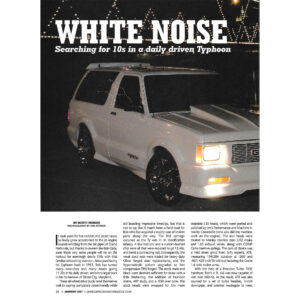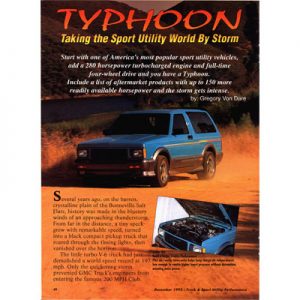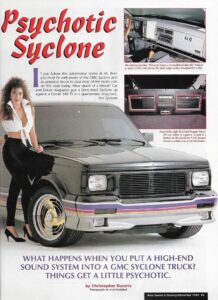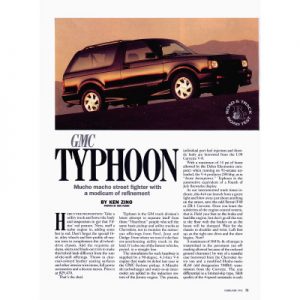Auto Sound & Security
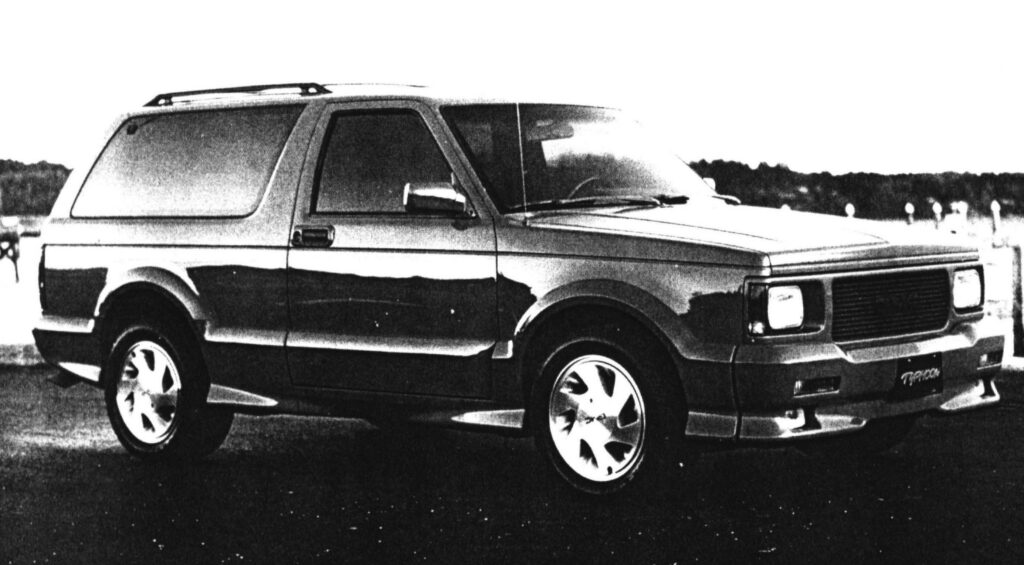
by Todd Matsubara
Typhoon The name says It all . This particular Typhoon belongs to Washington’s Bob Cooper. and hc1s been leaving a path of destruction on the IASCA competition circuit. Bob. installation manager at Silverdale. Washington’s Nuts About Ht-Fi knew that if you want to have an awesome system. you have to start with an awesome vehicle.
For those of you out there who don’t know and might think that a Typhoon is just a dressed up GMC Jimmy. think again! Rewind the clock to 1986: the debut of the recently redesigned Buick Grand National. To any of you non-car types out there. you probably still think that this is a normal Buick Regal, just painted black. WRONG! This was the last true muscle car to come out of Detroit. What made it tick? An intercooled. turbocharged, sequentially fuel-injected 3. 8 liter V-6 with gobs of torque and horsepower. The result was awesome acceleration, instant tire smoke at any speed, and Bad to the Bone! Just one problem: It wasn’t very useful off the dragstrip. Not enough brakes, bad handling, and no traction in inclement weather. Well, that car was only around in that form for two years, and when it went away, so did its engine. GM didn’t have a car to put it into since virtually all of its cars were changing over to front-wheel drive.
Fast forward to 1991. GM executives had the itch to revive the engine, but the only feasible body to fit anything similar to what the Grand National had was GMCs S-15 mini-truck. The engine was now displacing 4.3 liters and sported a more efficient turbocharging system. The result: more horsepower! But how could all of this newfound power not be turned into more tire smoke7 Full-time all-wheel drive. Now we’re getting somewhere. Throw in ABS and some performance tires and wheels and the result is a truck (that’s right, a truck!) that can run with the best performing vehicles in the world. But alas, it was still a standard cab truck. Never fear, the following year GMC introduced the fittingly named Typhoon, mechanically identical to the Syclone (the previously mentioned pickup truck) but with the spacious five-passenger interior of a GMC Jimmy. With a fully leather-trimmed interior, this vehicle comes equipped with everything you could ever want. Hmmmm. Except for that weak, underhorsepowered factory excuse for a high-end stereo system. Not to worry, that was taken care of.
One would think that with a vehicle like this. a wild audio system would be the on(y thing that would fit the truck’s character. However, very limited production numbers meant that the Typhoon could possibly have future collector value, so audio system modifications had to be planned out carefully. Bob feels that audio systems should be heard but not seen. so a “stealth” system was designed for the truck. The design also minimized vehicle modifications so that it could be returned to its stock condition at a later date, if desired.
First things first. Before any of the components were installed. the entire interior was removed so that Scosche Accumat could be used to dampen the body panels of the vehicle and to keep out any road noise that may try to work its way into the cabin. Once this “prep” work was done. the actual installation of the system began.
For the main source. a Clarion 5790 AM/FM/cassette/CD changer controller was mounted in the factory dash location. The head unit was flush-mounted with ABS which was color-matched to the truck’s interior. Although the unit sits flush with its trimpiece, its detachable face can still be removed for security purposes.
A three-inch Sony video monitor. model KVX-370. was installed in the factory glovebox. The unit automatically powers up when the glovebox is opened. and shuts down when it is closed. eliminating the need for any manual switches.
For signal processing, a Clarion 920 equalizer was chosen. This unit is flushmounted in a custom-fabricated overhead center console. The console is finished in headliner material which was matched to the truck’s stock headliner. The system’s two 3-1/2-inch center channel speakers are also installed in this console. Each of these Kicker F 3.5s has its own sealed fiberglass enclosure.
A second overhead console resides in the rear of the truck. This is where the forward-facing Clarion 2060 CD changer and the Sony SVX-20 VCR player are installed. Factory-matched headliner material was used to finish this console. Also, because safety was another constant when designing this system, rearward vision was not obstructed in any way.
Amplification for the system comes from a trio of Kicker amplifiers: one 50si and two 100sis. These are located in the tailgate in a fiberglass enclosure which was painted red to match the exterior of the truck. The entire rack is covered with Plexiglas for protection, and is cooled via two cooling fans in a push-pull configuration. To keep the amp rack invisible and for added security, a panel with factory carpet can be secured over the Plexiglas cover.
The amplifiers power a full complement of Kicker speakers. Up front in the upper corner of each door panel, an ND25 tweeter is installed in a custom- molded fiberglass pod. The location and angle of these speakers were decided upon after many hours of experimentation and critical listening. The stock dash locations each house one F4 4-inch midrange. These were installed on baffles which were fabricated to fit in the stock 4×6 opening.
The system’s midbass drivers are located in the lower portion of the doors. Each door contains two F5.25 5-1/4-inch midwoofers in a weatherproofed MDF enclosure. The stock map pockets on each door were replaced with new panels that had speakers grilles on them. Factory vinyl was used to upholster this panel to give it a stock appearance.
Installed in each stock rear side panel location is another ND25 tweeter and another F5.25 midbass driver. These are mounted on baffles that are installed in the original 6×9 opening.
The system’s single S8A 8-inch subwoofer is installed in the right rear of the truck. This driver is from Kicker’s Solobaric line. This series of woofers is specifically designed to function in smaller enclosures – perfect for this application. The enclosure was constructed from 3/4-inch MDF and was reinforced and bonded to the inner wall with fiberglass. Bondo was used to smooth the front of the enclosure, and then it was painted to match the exterior of the truck. Finally, a metal grille with black grille cloth was used to finish off the subwoofer portion of the system. Note that for consistency. the black cloth used here was used on all the grilles throughout the vehicle.
In the electrical department. the stock battery was upgraded to an Optima 800. Since Bob felt that the stock charging system was adequate. the stock alternator was left alone. All system fusing and wiring (signal and power) is by Scosche. At this point. you must be thinking that this install took a period of months to complete. Well, not quite. It was actually done in a period of weeks, in a mad scramble to ready it for the ’93 IASCA Finals in Tulsa. Was it done enough? A very impressive eighth place finish in the Pro 101250 class says a resounding. “Yes!” Of course, without the help of Bob’s friends (and Team Northwest teammates), Don Leistiko, Peter Dow, Dan Leonhardt, and Khalid Al Wahaibi (Khalid is also co-owner of the truck), it probably wouldn’t have been finished in time. (If you didn’t know. Team Northwest is a group of competitors from the Northwest area who travel to shows together.)
As for the ’94 season. Bob isn’t sure what his plans are, but one thing is certain … if Bob does compete. everyone had better take cover, because this Typhoon will definitely leave a path of destruction on the IASCA circuit!


